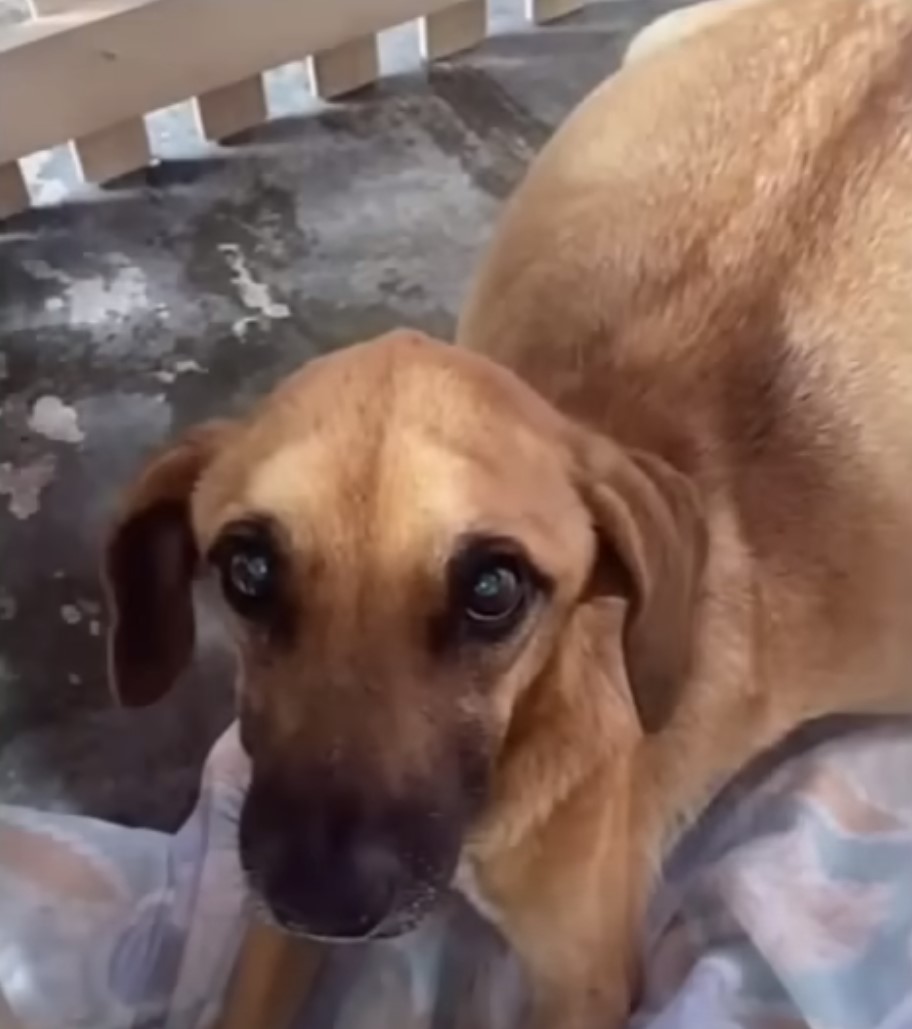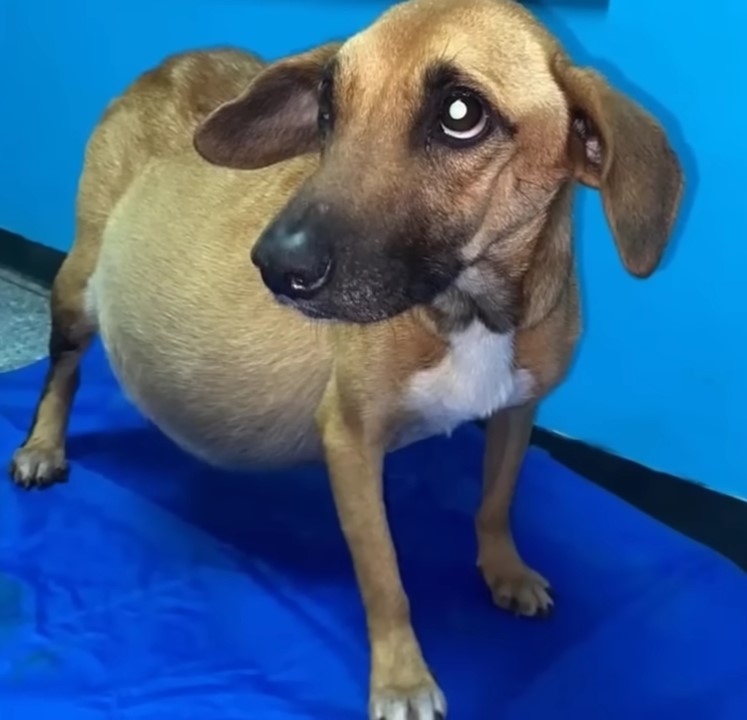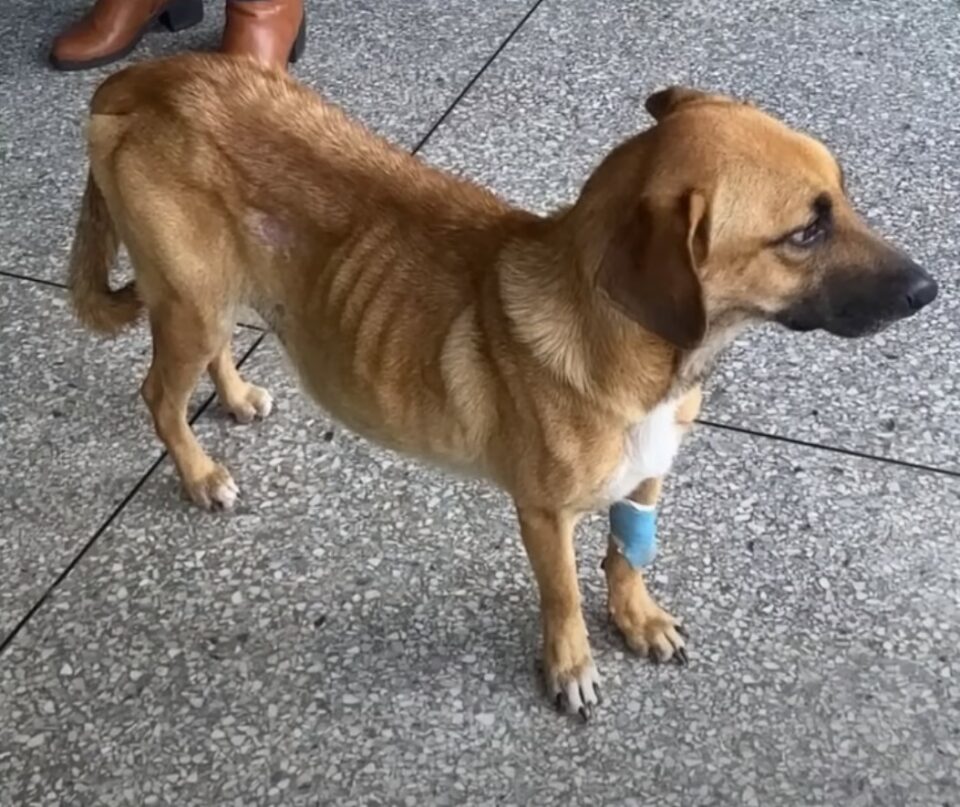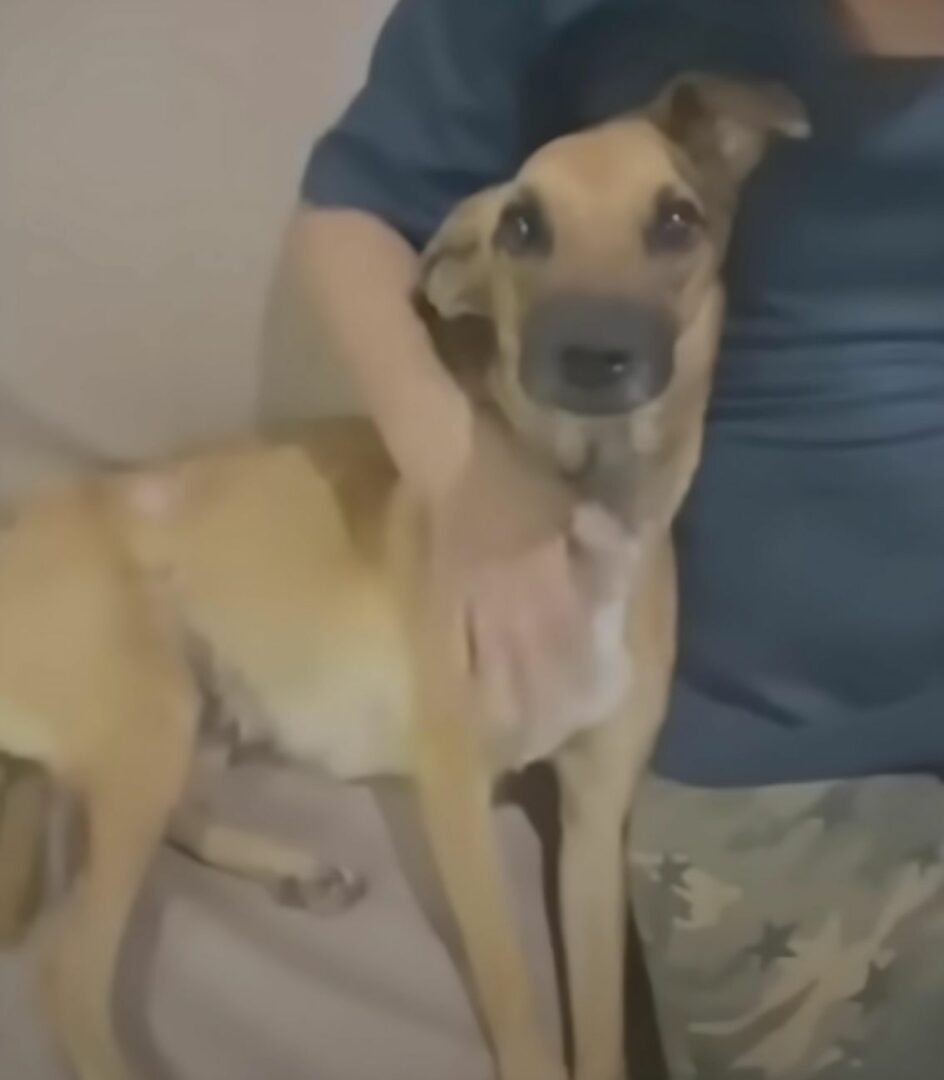It’s a truly heartbreaking moment when your loving pet mysteriously falls ill. Even though you may be very confused and scared, it’s crucial to stay by their side, offering solace, love, and comfort — and, of course, taking them to the vet for the care they need.
But please, never abandon them, as they are extremely vulnerable in this state.
Unfortunately, the sweet puppy of today’s story suffered this exact fate.
Unfortunate Fate

When a sweet pup was thrown out of a truck and into a landfill, at first, she thought that it was some kind of mistake, so she tried to run after the truck, but when she was unable to catch up to him, she just collapsed on the road.
Even then, she tried to crawl, but she was just too sick.
Luckily, rescuers noticed her struggles and immediately jumped in to help. The pup had an enormous belly, so naturally, they thought she was pregnant. But, they soon found out that this wasn’t the case.

The rescuers found out that the poor girl wasn’t actually pregnant, her belly was just so swollen that it resembled a balloon ready to burst any second. But, the interesting thing was that she was extremely malnourished – her ribs and spine were completely visible.
She was a skinny pup with a huge belly!

When she finally arrived at the vet, the doctors couldn’t believe what they were seeing. After her examination, they found out that her stomach was full of liquid. This was most likely due to her liver not working properly.
She also had a very infested, open wound on her leg, preventing her from walking.
Helping Hands
Luckily, this sweet girl was in a safe environment where she could finally receive the help she so desperately needed.
The rescuers gave her some yummy food, which she ate in an instant, preparing her for the procedure to drain her stomach.

However, there was so much fluid in her stomach that the vets had to drain it multiple times. In the end, more than a gallon of fluid was drained from the poor girl’s belly.
The next order of business was to nurse this incredible pup back to health. Since it was confirmed that she had liver failure, she was prescribed a lot of medication as well as constant observation.

After spending a month and a half at the vet, she was finally discharged. The hooman that took care of her the most completely fell in love with her and her reliance, so they decided to take her in.
Naming her Azalea, she took her home and allowed her to start a new chapter in her life.
The hooman was already a doggo parent, so Azalea had many pups that kept her company and showed her how fun it was to be a dog!

After two weeks, Azalea was taken to the vet for a check-up where it was determined that her medications were working and her liver was doing much better.
The vets were amazed to see this once depressed pup now run around happily, demanding attention and kisses from any hooman she encountered.
Azalea was finally happy!
Final Word
I am sure that, with time, this sweet girl will restore her health completely, gain a lot of healthy weight, and forget all about her dark past.
I also hope that this story will remind you that animals have feelings, too, and that abandoning them in time of need can seriously affect them.
Please, if your pups fall ill and you are no longer able to care for them or don’t know how to do it, take them to your local shelter, explain to the staff members what happened, and allow your furry friend a second chance at life.
If you’ve ever noticed your furry friend leaving puddles of drool behind, you’re not alone. Dog drooling is a common occurrence that can have various causes, some more harmless than others. As a seasoned dog trainer, I’ve seen it all when it comes to slobbery situations.
From excitement to medical issues, your dog’s drooling habits can tell you a lot about their well-being. Understanding the reasons behind this behavior can help you ensure your pup is happy and healthy. So, next time you catch your canine companion in a drooling daze, remember, there’s more to it than just a messy floor.
Understanding Dog Drooling
Normal Reasons for Drooling
Dogs drool as a natural response to certain situations. When your pup sees food, smells something appealing, or anticipates a treat, they may start drooling. It’s like us salivating when we think about our favorite meal. Playtime and excitement can also trigger drooling in dogs. So, if your furry friend is drooling a bit while waiting for their ball to be thrown, it’s usually nothing to worry about.
When Excessive Drooling Is a Concern
While some drooling is normal, excessive drooling can indicate an underlying issue. If you notice your dog dripping with saliva excessively without any apparent reason like food or play, it might be a sign of dental problems, mouth injuries, or nausea. In some cases, certain toxins or foreign objects could also cause excessive drooling. If your dog is drooling excessively and it’s not related to their usual triggers, it’s essential to consult your vet to rule out any health concerns.
Common Triggers of Excessive Drooling
Dental Issues and Gum Disease
If your dog is drooling excessively, dental issues and gum disease could be the culprits. Just like humans, dogs are prone to dental problems that can lead to increased saliva production. Check for signs of red or swollen gums, bad breath, or difficulty eating, as these could indicate a more significant problem.
Heatstroke and Dehydration
During hot weather or intense physical activity, dogs can experience heatstroke, leading to excessive drooling. Dehydration is another common trigger for increased saliva production. Ensure your furry companion has access to plenty of water, especially during hot days, to prevent overheating and dehydration.
Nausea and Digestive Problems
If your dog is feeling nauseous or experiencing digestive issues, they may drool excessively. Look for other symptoms like vomiting, diarrhea, or decreased appetite, which could point to an underlying health issue. Monitoring their eating habits and behavior can help determine if nausea is the cause of their drooling.
Anxiety and Stress
Just like humans, dogs can experience anxiety and stress, causing them to drool more than usual. Changes in their environment, loud noises, or separation anxiety can trigger stress-related drooling. Creating a safe and comfortable space for your dog and providing calming techniques can help reduce their stress levels and alleviate excessive drooling.
Medical Reasons Behind Excessive Drooling
Oral and Pharyngeal Diseases
When your dog drools excessively, oral and pharyngeal diseases could be the culprit. Issues like dental problems, gum disease, or mouth infections can lead to increased drooling. Keep an eye out for signs such as swollen gums, bad breath, or difficulty eating as indicators of potential oral health issues. Regular dental check-ups and proper oral hygiene can help prevent these conditions.
Neurological Disorders
Excessive drooling in dogs can sometimes be linked to neurological disorders. Conditions like seizures, nerve damage, or brain tumors may cause abnormal drooling patterns. If your dog exhibits other neurological symptoms like uncoordinated movements or sudden behavior changes alongside drooling, it’s crucial to seek veterinary care promptly for a thorough evaluation and appropriate treatment.
Toxins and Foreign Objects
Toxins or foreign objects that your dog ingests can trigger excessive drooling as the body tries to expel the harmful substances. Certain plants, chemicals, medications, or even small objects can lead to drooling if consumed. If you suspect your dog has ingested a toxic substance or a foreign object, contact your veterinarian immediately. Prompt intervention is essential to prevent further complications and ensure your dog’s well-being.
Remember, it’s essential to pay attention to changes in your dog’s drooling behavior and associated symptoms to identify potential medical reasons behind excessive drooling. Seeking veterinary advice and timely intervention can help address underlying health issues and ensure your furry companion stays happy and healthy.
When to See the Vet
Assessing the Urgency
If your dog is excessively drooling and showing signs of distress, such as difficulty swallowing, pawing at the mouth, or bloody saliva, it’s essential to seek veterinary care promptly. These symptoms may indicate a severe underlying issue that requires immediate attention to ensure your dog’s well-being.
What to Expect During the Examination
During the veterinary examination, the vet will conduct a thorough physical assessment of your dog, focusing on the mouth, teeth, and gums. They may also inquire about your dog’s recent behavior, diet, and any changes in drooling patterns. Further diagnostic tests, such as blood work or imaging scans, may be recommended to identify the root cause of the excessive drooling and determine the appropriate treatment plan.
Managing Your Drooling Dog at Home
Home Care Tips
- Regular Mouth Check: Check your dog’s mouth frequently for any signs of dental issues, foreign objects, or injuries.
- Maintain Dental Hygiene: Brush your dog’s teeth regularly to prevent dental problems that may cause excessive drooling.
- Comfortable Feeding Area: Ensure your dog eats comfortably to avoid stress-related drooling.
- Provide Fresh Water: Always have fresh water available for your dog to prevent dehydration and excessive drooling.
- Control Food Intake: Be cautious about the type and quantity of food your dog consumes to prevent overeating that could lead to drooling.
- Limit Toxins: Keep harmful substances out of reach to prevent accidental ingestion leading to excessive drooling.
- Regular Vet Visits: Schedule routine check-ups with your veterinarian to monitor your dog’s oral health and address any potential drooling issues early on.
- Training and Socialization: Proper training and socialization can help reduce stress-induced drooling in your dog.
- Healthy Diet: Feed your dog a balanced diet to maintain overall health and minimize drooling caused by certain foods.
- Safe Environment: Create a safe environment for your dog to prevent injuries that could result in excessive drooling.
- Stress Management: Manage your dog’s stress levels through exercise, mental stimulation, and a comforting routine to reduce anxiety-related drooling.
Remember, observing and addressing your dog’s drooling early on can help maintain their well-being and prevent any underlying health issues. Regular care, attention, and a safe environment are key to managing your drooling dog at home.
Conclusion
So, there you have it – a rundown on why your furry friend might be drooling like a leaky faucet. From food to dental problems, injuries to toxins, there are various reasons behind this slobbery situation. Remember, keeping an eye out for unusual drooling patterns and seeking help from your vet when needed is crucial for your dog’s health. Whether it’s a dental check-up, monitoring symptoms, or quick intervention, staying proactive is key. By understanding the potential causes and knowing when to seek professional advice, you can ensure your pup stays happy, healthy, and drool-free. So, next time you catch your dog in a drooling dilemma, you’ll be armed with the knowledge to tackle the issue head-on. Stay vigilant, stay informed, and most importantly, keep those tails wagging!
Frequently Asked Questions
What are some common triggers of dog drooling?
Common triggers of dog drooling include excitement, food, dental problems, injuries, nausea, toxins, and foreign objects.
What additional causes may lead to excessive drooling in dogs?
Additional causes of excessive drooling can stem from oral and pharyngeal diseases, neurological disorders, and ingestion of toxins or foreign objects.
When should I seek veterinary advice for my drooling dog?
Seek veterinary advice if your dog displays abnormal drooling patterns, symptoms like swollen gums or changes in behavior, or signs of distress like difficulty swallowing or bloody saliva.
What can I expect during a veterinary examination for my drooling dog?
During a veterinary examination, expect a thorough physical assessment focusing on the mouth, teeth, and gums, along with potential diagnostic tests like blood work or imaging scans.
How can I manage a drooling dog at home?
Manage a drooling dog at home by conducting regular mouth checks, maintaining dental hygiene, creating a comfortable feeding area, controlling food intake, limiting toxins, and scheduling routine vet visits.
[no_toc]

Hey there, I’m Janet Brooks, a dog-loving student from California. I’m all about helping pups in need, especially those without homes. Me and my awesome friends work together to give shelter and love to stray dogs. Oh, and I also write blogs about dogs to share helpful info.